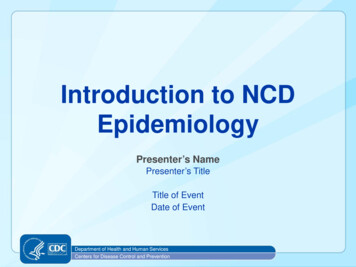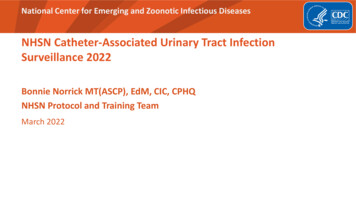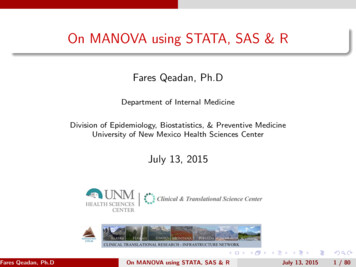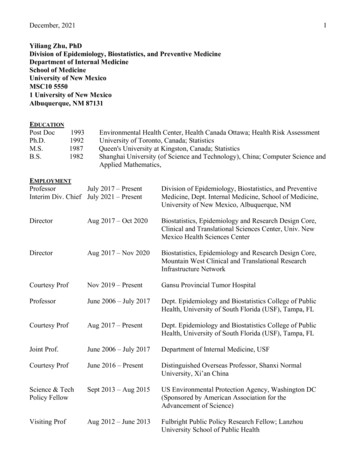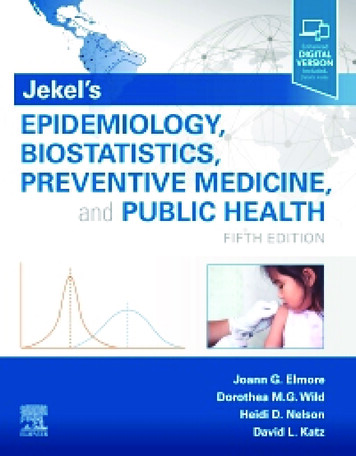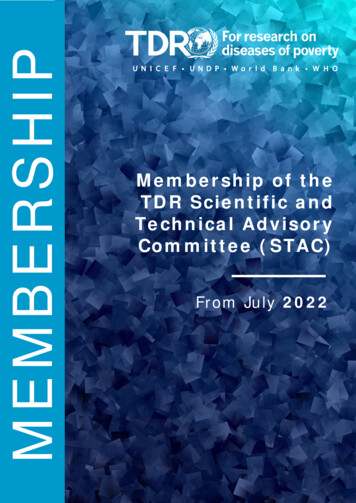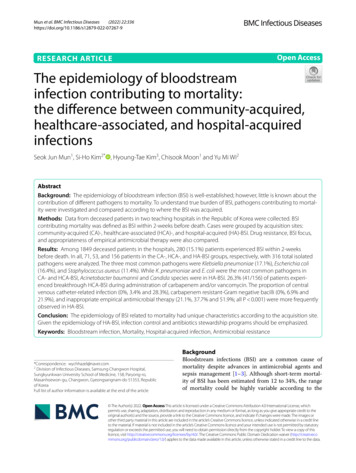
Transcription
(2022) 22:336Mun et al. BMC Infectious Open AccessRESEARCH ARTICLEThe epidemiology of bloodstreaminfection contributing to mortality:the difference between community‑acquired,healthcare‑associated, and hospital‑acquiredinfectionsSeok Jun Mun1, Si‑Ho Kim2* , Hyoung‑Tae Kim3, Chisook Moon1 and Yu Mi Wi2AbstractBackground: The epidemiology of bloodstream infection (BSI) is well-established; however, little is known about thecontribution of different pathogens to mortality. To understand true burden of BSI, pathogens contributing to mortal‑ity were investigated and compared according to where the BSI was acquired.Methods: Data from deceased patients in two teaching hospitals in the Republic of Korea were collected. BSIcontributing mortality was defined as BSI within 2-weeks before death. Cases were grouped by acquisition sites:community-acquired (CA)-, healthcare-associated (HCA)-, and hospital-acquired (HA)-BSI. Drug resistance, BSI focus,and appropriateness of empirical antimicrobial therapy were also compared.Results: Among 1849 deceased patients in the hospitals, 280 (15.1%) patients experienced BSI within 2-weeksbefore death. In all, 71, 53, and 156 patients in the CA-, HCA-, and HA-BSI groups, respectively, with 316 total isolatedpathogens were analyzed. The three most common pathogens were Klebsiella pneumoniae (17.1%), Escherichia coli(16.4%), and Staphylococcus aureus (11.4%). While K. pneumoniae and E. coli were the most common pathogens inCA- and HCA-BSI, Acinetobacter baumannii and Candida species were in HA-BSI. 26.3% (41/156) of patients experi‑enced breakthrough HCA-BSI during administration of carbapenem and/or vancomycin. The proportion of centralvenous catheter-related infection (0%, 3.4% and 28.3%), carbapenem resistant-Gram negative bacilli (0%, 6.9% and21.9%), and inappropriate empirical antimicrobial therapy (21.1%, 37.7% and 51.9%; all P 0.001) were more frequentlyobserved in HA-BSI.Conclusion: The epidemiology of BSI related to mortality had unique characteristics according to the acquisition site.Given the epidemiology of HA-BSI, infection control and antibiotics stewardship programs should be emphasized.Keywords: Bloodstream infection, Mortality, Hospital-acquired infection, Antimicrobial resistance*Correspondence: wychhazel@naver.com2Division of Infectious Diseases, Samsung Changwon Hospital,Sungkyunkwan University School of Medicine, 158, Paryong‑ro,Masanhoewon‑gu, Changwon, Gyeongsangnam‑do 51353, Republicof KoreaFull list of author information is available at the end of the articleBackgroundBloodstream infections (BSI) are a common cause ofmortality despite advances in antimicrobial agents andsepsis management [1–3]. Although short-term mortality of BSI has been estimated from 12 to 34%, the rangeof mortality could be highly variable according to the The Author(s) 2022. Open Access This article is licensed under a Creative Commons Attribution 4.0 International License, whichpermits use, sharing, adaptation, distribution and reproduction in any medium or format, as long as you give appropriate credit to theoriginal author(s) and the source, provide a link to the Creative Commons licence, and indicate if changes were made. The images orother third party material in this article are included in the article’s Creative Commons licence, unless indicated otherwise in a credit lineto the material. If material is not included in the article’s Creative Commons licence and your intended use is not permitted by statutoryregulation or exceeds the permitted use, you will need to obtain permission directly from the copyright holder. To view a copy of thislicence, visit http:// creat iveco mmons. org/ licen ses/ by/4. 0/. The Creative Commons Public Domain Dedication waiver (http:// creat iveco mmons. org/ publi cdoma in/ zero/1. 0/) applies to the data made available in this article, unless otherwise stated in a credit line to the data.
Mun et al. BMC Infectious Diseases(2022) 22:336acquisition site (whether community or hospital-acquiredBSI), a specific population, pathogens, drug resistance,and geographical region [1–8]. For example, hospitalacquired (HA)-BSI usually show higher crude mortality than community-acquired (CA)-BSI [2]. AlthoughEscherichia coli is the most common pathogen causingBSIs worldwide, higher mortality has been reported withbacteremia due to other Gram-negative bacteremia otherthan E. coli [3, 9, 10]. Therefore, the epidemiology ofpathogens contributing to mortality may differ from theactual bacteremia incidence of each specific pathogen.In the Republic of Korea, E. coli, Staphylococcus aureus,and Klebsiella pneumoniae were the three most common pathogens of true bloodstream infection; In reportsafter the 2000s, drug resistance of Gram-negative bacilli(GNB) has been a more predominant problem than thatof Gram-positive cocci (GPC) [10, 11]. Carbapenemresistance has been frequently observed with Acinetobacter baumannii, and reported to be more than 90%in a surveillance study in 2017 [12]. Although there aredata on the proportion of each pathogen isolated fromBSIs and their drug resistance, data on pathogens causingmortality and the extent of their contribution are rarelyreported.We believed that knowing the epidemiology of BSIscontributing to mortality and their susceptibility patternscould help better understand BSIs and set priority forinfection control and institutional or national antibioticpolicy. Therefore, this retrospective study was conductedto investigate pathogens related to mortality and to compare species and their characteristics according to wherethe BSI was acquired.MethodsStudy design and definitionAdult patients ( 18 years old) admitted to one of twoteaching hospital between January 2019 and December2019 were enrolled. The participating institutions wereSamsung Changwon Hospital and Inje University BusanPaik Hospital located in Changwon and Busan, Korea,respectively. Electronic medical records were reviewed tocollect data of laboratory results and clinical characteristics of patients.We defined BSIs contributing mortality as a BSI withinthe 2-weeks before death, as prior studies have used a14-day mortality to represent short-term mortality fromBSI [8]. The results of blood cultures performed on thestudy population during the 2-weeks before death werecollected. When bacteria or fungi were isolated frommore than two separate blood samples or from a singleblood sample in patients with explainable clinical symptoms and focuses other than skin commensals, they wereconsidered as true BSIs [13]. We only considered isolatedPage 2 of 7pathogens from true BSI as the pathogens contributing tomortality.Patients and their isolated pathogens were classifiedby their acquisition sites: Community-acquired (CA)-,healthcare-associated (HCA)- and HA-BSI. HCA infection was defined as infected patients with at least oneof the four elements: (1) Parenteral treatment within30 days, (2) outpatient chemotherapy or hemodialysiswithin 30 days, (3) hospitalization for 2 days in the preceding 90 days and (4) nursing home residence [14]. Tocompare baseline characteristics of patients and pathogens in CA-, HCA-, and HA-BSI groups, the followingdata were collected: age, sex, underlying disease, priormajor surgery (within 4 weeks), prior antibiotics use(within 4 weeks), infection focus of BSI, and appropriateness of empirical antimicrobial treatment. Appropriate empirical antibiotic use was defined when agents towhich the microbes were susceptible were administeredwithin 48 h after obtaining the blood culture sample. Inaddition, the antimicrobial susceptibility of each pathogen was classified into four major resistance patterns:cefotaxime-resistant Enterobacteriaceae (not including carbapenem-resistant), carbapenem-resistant GNB(CRGNB), methicillin-resistant S. aureus (MRSA), andvancomycin-resistant Enterococcus (VRE). Stenotrophomonas maltophilia, which has intrinsic resistance to carbapenem, was also classified as CRGNB [15]. In addition,difficult-to-treat resistance (DTR), defined as nonsusceptibility to all β-lactams and fluoroquinolones tested, wasidentified among CRGNB [16, 17].Blood culture and drug sensitivity testBlood was taken via a peripheral vein and/or a central line. Blood was drawn for two sets of blood culturebottles (aerobic and anaerobic, 8-10 cc blood for eachbottle), and culture bottles were incubated in the Bactec-9240 system (Becton Dickinson, Sparks, MD) orBacT/Alert 3D system (bioMérieux Inc., Marcy l’Etoile,France).). All samples were cultured in blood agar andMacConkey agar plates in a 35 C incubator for 24 hand identified using the Vitek MS system (BioMérieux,Hazelwood, MI, USA). All antimicrobial susceptibilitytests (ASTs) were performed using A Vitek II automatedsystem (bioMérieux Inc.) according to the Clinical andLaboratory Standards Institute 2018 guidelines [18]. Allprocedures were performed according to the manufacturer’s instructions.Statistical analysisAll statistical analyses were performed using SPSS 23.0for Window (IBM Corp., 2015, Chicago, IL, USA). Tocompare characteristics between the CA-, HCA-, andHA-BSI groups, a Student’s t-test or Mann–Whitney test
Mun et al. BMC Infectious Diseases(2022) 22:336Page 3 of 7was used to compare continuous variables of two groups,and a one-way analysis of variance (ANOVA) or Kruskal–Wallis test was used to compare continuous variables ofmultiple groups. Categorical variables were compared byusing the chi-square test or Fisher’s exact test. For posthoc analysis for multiple comparison, the Bonferronimethod was used. All P values were two-tailed, and P values 0.05 were considered statistically significant.ResultsStudy populationDuring the study period, a total of 1849 patients died.There were 331 patients with positive blood cultureduring the 2-weeks prior to death. After excluding twopatients under 18 years of age and 49 patients with contaminated blood cultures, 280 (15.1%) patients wereincluded in this study. The mean age of the study population was 69.92 years, and the ratio of males to femaleswas 3:2. Seventy-one (25.4%), 53 (18.9%), and 156 (55.7%)patients were classified as CA-, HCA- and HA-BSIacquired infection, respectively. Whereas liver diseasewas more frequently observed in the CA-BSI group, cardiovascular disease was more frequently observed in theHA-BSI group. Malignancy and prior antibiotic use weremore frequently observed in HCA- and HA-BSI groupsthan in the CA-BSI group (Table 1).Species of isolated pathogensA total of 316 pathogens were isolated from blood culture, and 74 (23.4%), 58 (18.4%) and 184 (58.2%) pathogens were identified from the CA-, HCA- and HA-BSIgroups, respectively. Of the 280 patients, 34 patientsexperienced polymicrobial BSI in single BSI event ormore than 2 consecutive BSI events, of which the HABSI group accounted for 75% (26/34).The five most common pathogens were Klebsiellapneumonia (17.1%), Escherichia coli (16.4%), Staphylococcus aureus (11.4%), Acinetobacter baumannii (10.8%),and Candida species (9.2%). The commonest pathogen inCA-, HCA-, and HA-BSI groups were E. coli, K. pneumoniae and A. baumannii (Table 2). Common isolated pathogens from each hospital were relatively similar and aredescribed in Additional file 1: Tables S1 and S2. No difference in patient age was observed among the pathogengroups (Additional file 1: Table S3).Overall, 54.5% (85/156) of patients in the HA-BSIgroup had a central venous catheter, and 37.2% (58/156)of patients were admitted to the intensive care unit whenBSI occurred (not shown in Table). In addition, 26.3%(41/156) of patients experienced breakthrough HCA-BSIduring administration of carbapenem and/or vancomycin. The most commonly isolated pathogen during carbapenem therapy was A. baumannii (Additional file 1:Table S4).Comparison of characteristics between CA‑, HCA‑and HA‑BSIFigure 1 shows the characteristics of each BSI group.Almost all of the fungi were isolated from the HA-BSIgroup. Candida species comprised 96.6% (28/29) of fungiisolates, and C. albicans was the most predominant (17cases of 28 Candida species) (Fig. 1A). Meanwhile, themost common portal of BSI entry was primary or froman unknown focus. Central venous catheter-related infection was more frequently observed in the HA-BSI groupTable 1 Clinical characteristics of patients with BSI within 2-weeks before deathOverall (280)Communityacquired (71)Healthcareassociated (53)Hospital-acquired (156)69.92 12.9572.99 13.5768.75 12.3768.92 12.7286 (55.1)0.162Malignancy118 (42.1)19 (26.8)34 (64.2)65 (41.7) 0.001Diabetes85 (30.4)24 (33.8)13 (24.5)48 (30.8)0.532Hypertension120 (42.9)30 (42.3)27 (50.9)63 (40.4)0.411Cardiovascular disease73 (26.1)13 (18.3)8 (15.1)52 (33.3)0.007Pulmonary disease26 (9.3)7 (9.9)1 (1.9)18 (11.5)0.093Liver disease56 (20.0)24 (33.8)10 (18.9)22 (14.2)0.004Rheumatologic disease12 (4.3)1 (1.4)1 (1.9)12 (4.3)0.184Renal disease25 (8.9)3 (4.2)3 (5.7)19 (12.2)0.136Solid organ transplantation4 (1.4)0 (0.0)0 (0.0)4 (2.6)Prior major surgery35 (12.5)0 (0.0)4 (7.5)31 (19.9) 0.001HA CAPrior antibiotics use124 (44.3)2 (2.8)34 (64.2)88 (56.4) 0.001HCA,HA CAAgeSex (male)168 (60.0)48 (67.6)34 (64.2)Data represent the number (%) of patients, unless otherwise specifiedBSI bloodstream infection; HCA healthcare-associated infection; CA community-acquired infection; HA hospital-acquired infectionP valuePost-hoc analysis0.069HCA CA,HAHA HCACA HA0.392
Mun et al. BMC Infectious Diseases(2022) 22:336Page 4 of 7Table 2 Isolated pathogens from bloodstream infectionsOverall (316)Community acquired (74)Healthcare associated (58)Hospital acquired (184)Klebsiella pneumonia (54)Escherichia coli (20)Klebsiella pneumonia (17)Acinetobacter baumannii (33)Escherichia coli (52)Klebsiella pneumonia (15)Escherichia coli (11)Candida spp. (28)Staphylococcus aureus (41)Staphylococcus aureus (14)Staphylococcus aureus (7)Klebsiella pneumonia (22)Acinetobacter baumannii (34)Other Streptococcus spp. (11)Pseudomonas aeruginosa (4)Escherichia coli (21)Candida spp. (29)Proteus spp. (3)Other Streptococcus spp. (4)Staphylococcus aureus (20)Enterococcus faecium (24)Others (11)*Enterococcus faecium (3)Enterococcus faecium (20)Others (12)*Pseudomonas aeruginosa (9)Other Streptococcus spp. (21)Pseudomonas aeruginosa (13)Stenotrophomonas maltophilia (5)Enterococcus faecalis (6)Other Streptococcus spp. (5)Stenotrophomonas maltophilia (6)Enterococcus faecalis (3)Proteus spp. (6)Coagulase (-) Staphylococcus (3)Coagulase (-) Staphylococcus (4)Others (15)*Citrobacter spp. (3)Others* (25)*Pathogens isolated from blood culture fewer than three timesFig. 1 The comparison between community-acquired, healthcare-associated, and hospital-acquired bloodstream infection contributing tomortality. A Isolated pathogens, B Portal of entry, C Drug resistance, D Appropriateness of empirical treatment. GPC Gram-positive coccus;GNB Gram-negative bacillus; IAI intra-abdominal infection; CRI catheter-related infection; VRE Vancomycin-resistant Enterococcus; MRSAMethicillin-resistant Staphylococcus aureus(28.3%) than in the HCA-BSI group (3.4%) or the CA-BSIgroup (0%) (Fig. 1B).The most frequently observed drug resistance wascefotaxime-resistant Enterobacteriaceae, which was distributed relatively evenly amongst in the CA-BSI (21.6%),HCA-BSI (20.6%), and HA-BSI groups (17.9%). Therewas no significant difference in the VRE and MRSA proportions in the three BSI groups. However, CR-GNB wasthe predominant drug resistant pathogen in the HA-BSIgroup (21.9%) (Fig. 1C). The DTR pattern was identified
Mun et al. BMC Infectious Diseases(2022) 22:336in 81.8% (36/44) of CRGNBs. The most common speciesof CRGNB was A. baumannii (24 isolates), which rarelyor never contributed to mortality in HCA- (6.9%) or CABSIs (0%). Inappropriate empirical antimicrobial treatment was more frequently observed in HA-BSIs (51.9%)compared with HCA- (37.7%) and CA-BSIs (21.1%)(Fig. 1D). In our study population, 65 cases of BSI wereempirically treated with type 2 carbapenems and glycopeptides. However, the treatment was still inappropriatein 26.2% of these patients due to drug resistance (data notshown).DiscussionOur study showed common isolates from BSIs that contributed to mortality and patient clinical characteristics.Pathogens and characteristics of HA-BSIs related to mortality showed very different epidemiology from that ofCA-BSIs in terms of species, portal of entry, antimicrobial resistance pattern, and appropriateness of empiricalantimicrobial therapy. HA-BSIs contribute considerablyto mortality in hospital, and the combination of carbapenem and glycopeptides—which might be the most preferred empirical antibiotics regimens of clinicians—didnot prevent HA-BSIs nor did it meet the criterion ofappropriate antimicrobial therapy.GNBs more contributed to mortality than GPCs.Increasing antimicrobial resistance of GNB has beencontinuously reported and, along with the lack of newlicensed antibiotics since the 1990s, has become a significant problem [10, 11, 19]. In this study, cefotaximeresistant Enterobacteriaceae demonstrated the mostpredominant resistant pattern in the study population,especially in the CA-BSI group. Although ESBL-producing Enterobacteriaceae are usually associated with HAinfection, its acquisition in the community setting hasincreased since the mid-2000s [20]. Surveillance data ofantimicrobial resistance in South Korea in 2011 showedthat only 18.3% of E. coli were resistant to cefotaxime;however, resistance rates increased to 34.7% by 2017 [10,11]. Our study supported the real-world relationshipbetween increasing ESBL-producing Enterobacteriaceaeand mortality.CRGNBs or DTR-GNBs has been evolving as a challenging health problem in hospital acquired infection [11,16]. Numerically, 8.4% (156/1849) of patients who died inhospital had HA-BSI, and 25% (40/156) of these patientsdied because of acquisition of CRGNB bacteremia, whichwas most frequently caused by A. baumannii. Indeed, thehigh carbapenem resistance of A. baumannii has beenreported worldwide [12, 21]. Although colistin is usually the only treatment option for carbapenem-resistantAcinetobacter baumannii (CRAB), the efficacy of colistin for CRAB bacteremia is not very reliable [22]. OnePage 5 of 7multicenter study from South Korea reported the 28-daymortality of patients with CRAB bacteremia treated withcolistin at 61.4% [23]. However, even for patients withCRAB bacteremia who did not receive appropriate antibiotics, the mortality rate was 69.8% [24]. High mortality, difficulty in administration of appropriate empiricalantibiotics, and lack of reliable antimicrobial therapeutic options might be related to A. baumannii being themost predominant species from HA-BSI contributing tomortality in this study. Before effective treatment optionsagainst CRGNB to introduce, efforts are needed to comply with infection prevention management and to auditantibiotic prescriptions [25, 26].In our study, Candida species were reported as the second most common isolates for HA-BSIs causing patientmortality. Appropriate empirical treatment of candidemia is another challenging problem similar to bacteremia caused by multidrug resistant pathogens. Althoughearly appropriate treatment is associated with favorableoutcomes [27], only a few patients received appropriate empirical anti-fungal agents due to difficulty in earlydiagnosis [28]. In our study, only 28.6% of patients whodied with candidemia received appropriate antifungalagents. To reduce mortality resulting from candidemia,a more rapid and reliable diagnostic tool than blood culture is needed. The new T2Candida molecular test usingmagnetic resonance with molecular diagnostics has beenintroduced and is expected to be a rapid, promising toolfor the detection of candidemia [29]. However, due tohigh initial and maintenance costs, there is a difficultyin wide application of T2 Candida in the clinical setting[30]. More accessible tools with high accuracy for candidemia diagnosis should be developed.There were some limitations in our study. Even thoughour data were collected from two teaching hospitals, theepidemiology of BSI depends both on patient demographics and the geographical characteristics of eachhospital. For example, only a small number of transplantrecipients were included in our study; medical centersspecializing in transplantation might show different HABSI epidemiology. In addition, in our study, we only considered short-term mortality of BSI. From this study, wecannot infer long-term mortality or changes in disabilitycaused by BSI. Further studies are needed.ConclusionsIn conclusion, GNBs comprised a larger portion ofmicrobes related to mortality than GPCs. K. pneumoniae and E. coli were the predominate pathogens associated with mortality in CA- and HCA-BSIs, while A.baumannii and Candida species were for HA-BSI.Along with increasing drug resistance in GNB, inappropriate empirical therapy was primarily observed in
Mun et al. BMC Infectious Diseases(2022) 22:336the HA-BSI group because of difficulties in predictingdrug resistance and identifying fungal pathogens. Ourdata showed that, in the hospital setting, a significantnumber of patients die from acquired BSI, which theinfection control team should make every effort to prevent. A combination of carbapenem and glycopeptideled to other pathogens arising with higher resistanceor to fungal infection. The importance of infection prevention and antibiotics stewardship program should beemphasized, especially until more reliable treatmentoptions for multidrug resistant GNB and rapid diagnostic tools are introduced.AbbreviationsBSI: Bloodstrean infection; CA: Community-acquired; CRAB: Carbapenemresistant Acinetobacter baumannii; CRGNB: Carbapenem-resistant Gramnegative bacilli; DTR: Difficult-to-treat resistance; HA: Hospital-acquired;HCA: Healthcare-associated; GNB: Gram-negative bacilli; GPC: Gram-positivecocci; MRSA: Methicillin-resistant Staphylococcus aureus; VRE: Vancomycinresistant Enterococcus.Supplementary InformationThe online version contains supplementary material available at https:// doi. org/ 10. 1186/ s12879- 022- 07267-9.Additional file 1: Table S1. Isolated pathogen from Samsung Changwonmedical center. Table S2. Isolated pathogen from Inje University BusanPaik Hospital. Table S3. Age distribution of patients grouped by blood iso‑lates (P 0.838). Table S4. Breakthrough bloodstream infection in patientswith hospital-acquired bloodstream infection.AcknowledgementsNot applicable.Authors’ contributionsConceptualization, S-HK; Data curation, S-HK, SJM and H-TK; Formal analysis,S-HK; Methodology, S-HK, SJM and H-TK; Visualization, S-HK; Writing—originaldraft, S-HK, SJM, CM and YMW; Writing—review & editing, S-HK, SJM, H-TK, CMand YMW. All authors read and approved the final manuscript.FundingThis research was supported by the SungKyunKwan University and the BK21FOUR (Graduate School Innovation) funded by the Ministry of Education(MOE, Korea) and National Research Foundation of Korea (NRF).Availability of data and materialsThe datasets generated and/or analysed during the current study are notpublicly available, but are available from the corresponding author on reason‑able request.DeclarationsEthics approval and consent to participateThe study was approved by the Samsung Changwon Hospital and Busan PaikInstitutional Review Board (IRB number: SCMC 2020-12-013 and BPIRB 202101-005). The study was performed in accordance with the guidelines followedas per the Declaration of Helsinki. Informed consent was waived by the IRB ofKonkuk university of medical center since the electronic medical record wasreviewed retrospectively with de-personalized identification number.Consent for publicationThe manuscript is approved by all authors for publication.Page 6 of 7Competing interestsThe authors declare that they have no competing interests.Author details1Division of Infectious Diseases, Department of Internal Medicine, Inje Uni‑versity College of Medicine, Inje University Busan Paik Hospital, Busan, SouthKorea. 2 Division of Infectious Diseases, Samsung Changwon Hospital, Sungk‑yunkwan University School of Medicine, 158, Paryong‑ro, Masanhoewon‑gu,Changwon, Gyeongsangnam‑do 51353, Republic of Korea. 3 Departmentof Laboratory Medicine, Samsung Changwon Hospital, Sungkyunkwan Univer‑sity School of Medicine, Changwon, Republic of Korea.Received: 30 April 2021 Accepted: 13 March 2022References1. Goto M, Al-Hasan MN. Overall burden of bloodstream infection andnosocomial bloodstream infection in North America and Europe. ClinMicrobiol Infect. 2013;19(6):501–9.2. Diekema DJ, Beekmann SE, Chapin KC, Morel KA, Munson E, Doern GV.Epidemiology and outcome of nosocomial and community-onset blood‑stream infection. J Clin Microbiol. 2003;41(8):3655–60.3. Søgaard M, Nørgaard M, Dethlefsen C, Schønheyder HC. Temporalchanges in the incidence and 30-day mortality associated with bactere‑mia in hospitalized patients from 1992 through 2006: a population-basedcohort study. Clin Infect Dis. 2011;52(1):61–9.4. Seboxa T, Amogne W, Abebe W, Tsegaye T, Azazh A, Hailu W, et al. Highmortality from blood stream infection in Addis Ababa, Ethiopia, is due toantimicrobial resistance. PLoS ONE. 2015;10(12):e0144944.5. Koehler P, Stecher M, Cornely OA, Koehler D, Vehreschild M, Bohlius J,et al. Morbidity and mortality of candidaemia in Europe: an epidemio‑logic meta-analysis. Clin Microbiol Infect. 2019;25(10):1200–12.6. Dickstein Y, Lellouche J, Ben Dalak Amar M, Schwartz D, Nutman A,Daitch V, et al. Treatment outcomes of colistin- and carbapenem-resistantAcinetobacter baumannii infections: an exploratory subgroup analysis of arandomized clinical trial. Clin Infect Dis. 2019;69(5):769–76.7. Kim SH, Cha MK, Kang CI, Ko JH, Huh K, Cho SY, et al. Pathogenic signifi‑cance of hemorrhagic pneumonia in hematologic malignancy patientswith Stenotrophomonas maltophilia bacteremia: clinical and microbio‑logical analysis. Eur J Clin Microbiol Infect Dis. 2019;38(2):285–95.8. Neuner EA, Yeh J-Y, Hall GS, Sekeres J, Endimiani A, Bonomo RA, et al.Treatment and outcomes in carbapenem-resistant Klebsiella pneumoniaebloodstream infections. Diagn Microbiol Infect Dis. 2011;69(4):357–62.9. Kang CI, Song JH, Chung DR, Peck KR, Ko KS, Yeom JS, et al. Risk factorsand pathogenic significance of severe sepsis and septic shock in 2286patients with Gram-negative bacteremia. J Infect. 2011;62(1):26–33.10. Huh K, Kim J, Cho SY, Ha YE, Joo E-J, Kang C-I, et al. Continuous increaseof the antimicrobial resistance among Gram-negative pathogens causingbacteremia: a nationwide surveillance study by the Korean Networkfor Study on Infectious Diseases (KONSID). Diagn Microbiol Infect Dis.2013;76(4):477–82.11. Lee H, Yoon E-J, Kim D, Jeong SH, Won EJ, Shin JH, et al. Antimicrobialresistance of major clinical pathogens in South Korea, May 2016 toApril 2017: first one-year report from Kor-GLASS. Eurosurveillance.2018;23(42):1800047.12. Liu C, Yoon E-J, Kim D, Shin JH, Shin JH, Shin KS, et al. Antimicrobialresistance in South Korea: a report from the Korean global antimicrobialresistance surveillance system (Kor-GLASS) for 2017. J Infect Chemother.2019;25(11):845–59.13. Seifert H. The clinical importance of microbiological findings in thediagnosis and management of bloodstream infections. Clin Infect Dis.2009;48(Suppl 4):S238–45.14. Friedman ND, Kaye KS, Stout JE, McGarry SA, Trivette SL, Briggs JP, et al.Health care-associated bloodstream infections in adults: a reason tochange the accepted definition of community-acquired infections. AnnIntern Med. 2002;137(10):791–7.15. Chang YT, Lin CY, Chen YH, Hsueh P-R. Update on infections caused byStenotrophomonas maltophilia with particular attention to resistance
Mun et al. BMC Infectious 30.(2022) 22:336Page 7 of 7mechanisms and therapeutic options. Front Microbiol. 2015. https:// doi. org/ 10. 3389/ fmicb. 2015. 00893.Kadri SS, Adjemian J, Lai YL, Spaulding AB, Ricotta E, Prevots DR, et al.Difficult-to-treat resistance in Gram-negative bacteremia at 173 US hospi‑tals: retrospective cohort analysis of prevalence, predictors, and outcomeof resistance to all first-line agents. Clin Infect Dis. 2018;67(12):1803–14.Huh K, Chung DR, Ha YE, Ko JH, Kim SH, Kim MJ, et al. Impact ofdifficult-to-treat resistance in Gram-negative bacteremia on mortality:retrospective analysis of nationwide surveillance data. Clin Infect Dis.2020;71(9):e487–96.Clinical and Laboratory Standards Institute (CLSI). Performance standardsfor antimicrobial susceptibility testing. 28th ed. CLSI supplement M100Wayne. 2018.Livermore DM. Current epidemiology and growing resistance of Gramnegative pathogens. Korean J Intern Med. 2012;27(2):128–42.Doi Y, Park YS, Rivera JI, Adams-Haduch JM, Hingwe A, Sordillo EM,et al. Community-associated extended-spectrum β-lactamaseproducing Escherichia coli infection in the United States. Clin Infect Dis.2013;56(5):641–8.Kamolvit W, Sidjabat HE, Paterson DL. Molecular epidemiology andmechanisms of carbapenem resistance of Acinetobacter spp. Asia andOceania. Microb Drug Resist. 2015;21(4):424–34.Garnacho-Montero J, Amaya-Villar R, Ferrándiz-Millón C, Díaz-Martín A,López-Sánchez JM, Gutiérrez-Pizarraya A. Optimum treatment strategiesfor carbapenem-resistant Acinetobacter baumannii bacteremia. ExpertRev Anti Infect Ther. 2015;13(6):769–77.Kim T, Park KH, Yu SN, Park SY, Park SY, Lee YM, et al. Early intravenouscolistin therapy as a favorable prognostic factor for 28-day mortality inpatients with CRAB bacteremia: a multicenter propensity score-matchinganalysis. J Korean Med Sci. 2019;34(39):e256.Kim T, Lee EJ, Park SY, Yu SN, Lee YM, Park KH, et al. Natural prognosis ofcarbapenem-resistant Acinetobacter baumannii bacteremia in patientswho did not receive appropriate antibiotic treatment: a retrospectivemulticenter study in
more frequently observed in HCA- and HA-BSI groups than in the CA-BSI group (Table 1). Species of isolated pathogens A total of 316 pathogens were isolated from blood cul-ture, and 74 (23.4%), 58 (18.4%) and 184 (58.2%) patho-gens were identied from the CA-, HCA- and HA-BSI groups, respectively. Of the 280 patients, 34 patients


